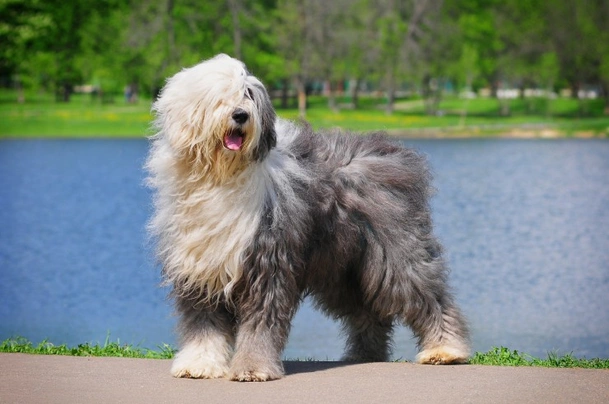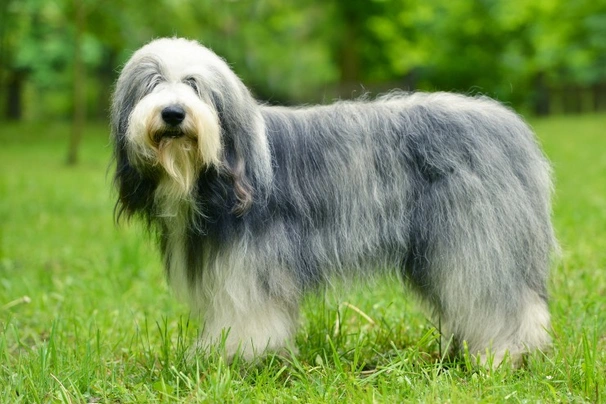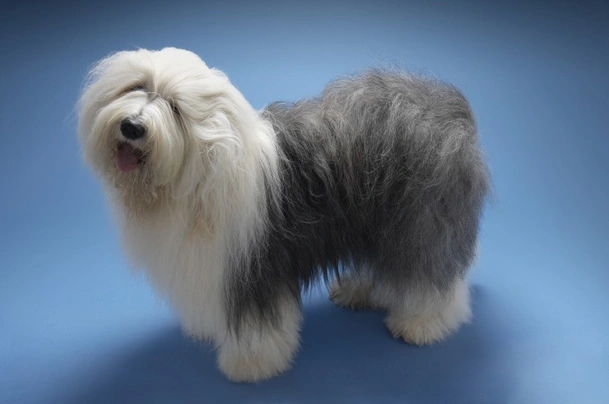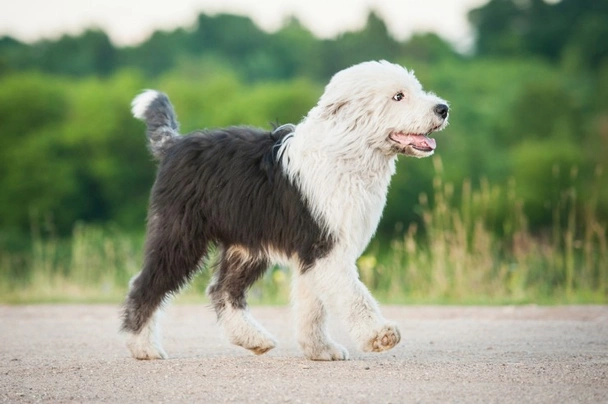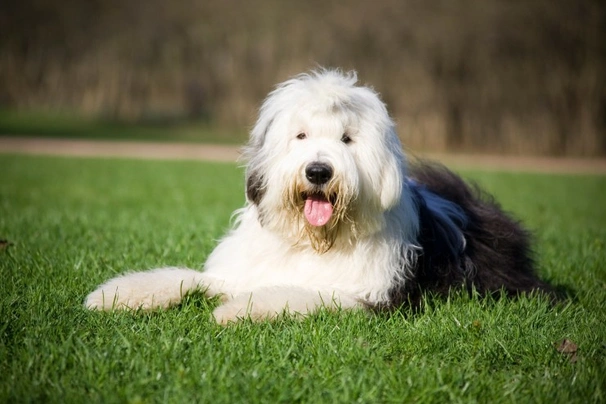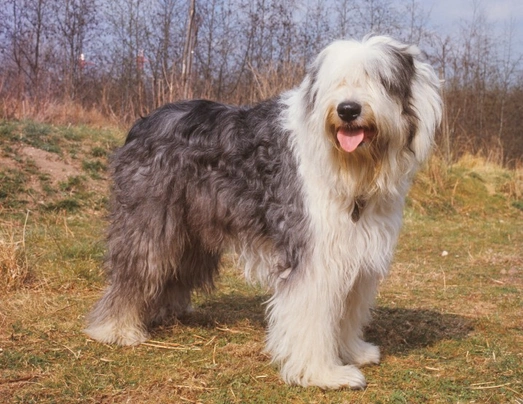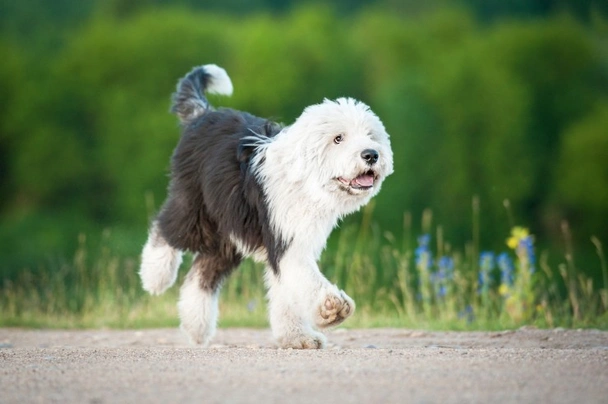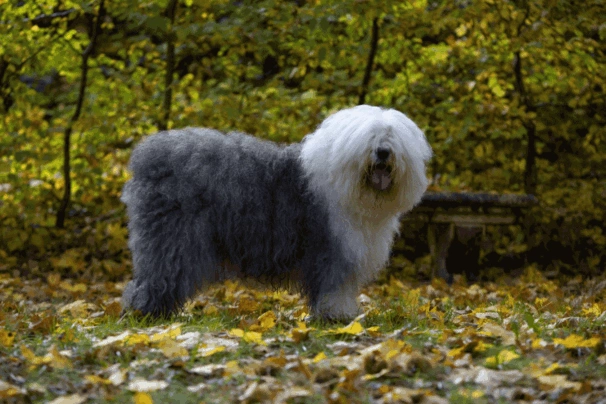Old English Sheepdog
Pros
Cons
Introduction of the Old English Sheepdog
The Old English Sheepdog must be one of the UK's most iconic breeds and for decades these charming dogs have been a popular choice both as companions and family pets with people all over the world and for good reason. Not only are they lovely looking dogs but they boast having loyal kind and affectionate natures too.
Often called Bob-Tails they are high maintenance on the grooming front and are known to shed a little throughout the year but daily brushing keeps the amount they shed to a minimum. They are better suited to households where one person typically stays at home because Old English Sheepdogs hate being left on their own and suffer from separation when they are left to their own devices for any length of time.
History of the Old English Sheepdog
The first time an Old English Sheepdog was depicted in a painting was in 1771 when Gainsborough painted a very similar looking dog with the Duke of Buccleugh that was referred to as being a "bobtail collie".
Although now considered a native breed there are some people who believe Old English Sheepdog could be a descendant of European shepherd dogs namely the Bergamasco and the Russian Ovtcharka both of which were introduced to the UK on sailing ships and then bred to various British sheep dog breeds which included the Scottish Bearded Collie. However other people think that other breeds were introduced into the mix which includes the French Sheepdog and the Briard.
With this said it was a Mr. Edward Lloyd who established that the Old English Sheepdog is in fact native to the South Downs a region in Sussex and that the breed has only been around for around 200 years or so. At the time these dogs went by other names which included the Cotswold Sheepdog Cor or Smithfield and they were used to work alongside cattle driving them to market. They were also used to drive New Forest ponies as well as sheep to Smithfield market hence one of their other names back in the day.
As such the dogs we see today have only been around since the 1800's and it's thought they were first developed in the South West of England where they were bred to work in challenging conditions and rough terrains guarding sheep with shepherds. They soon proved excellent at the job they were bred to do and thanks to their extremely water-resistant coats they could work in the harshest weather conditions with the added bonus being in warmer weather their coats could be sheared much in the same way as sheep. Shepherds’ wives would then spin a dog’s fur to make warm clothing for the colder winter months.
The first Old English Sheepdog exhibited at a dog show was in 1873 in Birmingham. From that point in time these lovely dogs became popular with people not only here in the UK but in the States Canada and other parts of the world. A breed standard was established very soon afterwards which has not been changed that much to this day.
The Old English Shepherd remains a popular choice of family pet and companion dog thanks to their charming looks and personable natures although anyone wishing to share a home with a Bob-Tail needs to have the time to dedicate to grooming them but the effort is well worthwhile.
Interesting facts about the breed
- Is the Old English Sheepdog a vulnerable breed? No they are among some of the more popular dogs in the UK
- An Old English Sheepdog has starred in many films and TV shows including the Shaggy Dog as well as many Disney cartoons
- Their coats allow the Old English Sheepdog to blend in with the flocks of sheep they were guarding and herding which gave them an advantage over predators
- They are known to have a very loud bark and are great watchdogs
- Traditionally like many other working breeds an Old English Sheepdog's tail was always docked but since the law banning the procedure came into effect in 2007 tail docking is now illegal with the only exception being because a dog suffers from some sort of health issue that requires their tails to be docked and the procedure has been agreed and authorised before being performed by a qualified vet. There are hefty fines associated with tail docking without the correct paperwork or permissions from the correct authorities. It is also worth noting that some OESs are born tailless hence their other name “bob-tail”
Appearance of the Old English Sheepdog
Height at the withers: Males 56 - 61 cm Females 56 - 61 cm
Average weight: Males 29.5 - 30.5 kg Females 29.5 - 30.5 kg
The Old English Sheepdog is known the world over thanks to their charming looks and their shaggy coats that cover their faces and entire bodies when not clipped out. Their heads are nicely in proportion with the rest of their body and are rather square being well arched above a dog's eyes. Stops are well defined and muzzles are square blunt and strong. Their noses are black and on the large side with wide nostrils. Their eyes are set nicely apart and can be either dark or dogs can be wall eyed with two blue eyes being acceptable under the breed standard.
Their ears are small for such a large dog which they carry flat to the side of their heads. The Old English Sheepdog has a strong jaw with a perfect scissor bite where their upper teeth neatly overlap their lower ones. Their necks are strong and quite long which dogs carry elegantly arched. Their front legs are straight and show a good amount of bone. Shoulders are well laid back with dogs being lower at their wither than they are at the loin.
Their bodies are compact yet rather short with dogs having well sprung ribs and nice deep briskets. Their loins are broad and sturdy being slightly arched and nicely rounded and muscular. They have long well developed second thighs and their feet are round and small with well arched tight toes and thick firm paw pads. An Old English Sheepdog can have a natural bobtail but when long their tails are nicely feathered.
When it comes to their coat the Old English Sheepdog has an abundance of harsh shaggy hair that covers their entire body and they have a dense extremely weather-resistant undercoat. The accepted breed colours for Kennel Club registration are as follows:
- Black & White
- Blue & White
- Blue Grey & White
- Grey
- Grey & White
Gait/movement
When an Old English Sheepdog moves they so with a rolling action that resembles the gait of a bear. When they trot they do so effortlessly showing a lot of drive coming from their hindquarters with their legs travelling in a straight line. At the gallop an Old English Sheepdog shows an elastic gait but when they are walking or trotting they typically pace. Dogs carry their heads naturally lower when they are on the move.
Faults
The Kennel Club frowns on any exaggerations or departures from the breed standard and would judge the faults on how much they affect a dog's overall health and wellbeing as well as their ability to perform.
Males should have both testicles fully descended into their scrotums and it is worth noting that a dog can be a little lighter or heavier as well as slightly taller or shorter than set out in the Kennel Club breed standard which is given as a guideline only.
Temperament of the Old English Sheepdog
The Old English Sheepdog is a loveable character and one that boasts a huge amount of energy which basically means they are a great choice for people who live in a more rural environment or who boast having very large and ultra-secure large back gardens. They are intelligent loyal and affectionate by nature and once they form a bond with an owner it remains unbreakable throughout their lives.
Bob-Tails boast having a strong herding instinct and will happily round the kids or other pets up when they are given the chance. They can become a little too over protective which is something that owners with very young children need to bear in mind. They have kind natures and stay playful right through to their golden years. Because they form such strong bonds with their owners the Old English Sheepdog thrives in a home environment where at least one person usually stays at home when everyone else is out of the house because these dogs thrive on having company around them and do not do well when left on their own. Providing they are given the right amount of daily exercise and lots of mental stimulation an Old English Sheepdog is quite happy to chill out around the home. If they are left to their own devices for long periods they are likely to get bored very quickly which could lead to a dog developing some unwanted and destructive behavioural issues which includes separation anxiety.
Old English Sheepdogs make great family pets for first time owners providing people have time to dedicate to their dogs because these adorable looking dogs need a lot in the way of exercise they are high maintenance in the grooming department and because they are so intelligent they need to be given a much mental stimulation as possible to keep them happy. They can be a little wary of strangers however rarely would an Old English Sheepdog show any sort of aggressive behaviour towards people they do not know preferring to just keep their distance and bark although in the main a visitor would be warmly welcomed if their owner is around.
Are they a good choice for first time owners?
Old English Sheepdogs are a good choice for first time dog owners but only if they have the time to dedicate to such a high energy dog. The OES is known to be amenable and people-oriented loving nothing more than to please and to entertain their families. They are particularly good with young children and older people too although playtime can get a bit boisterous at times which is why any interaction between younger children should always be well supervised.
What about prey drive?
The Old English Sheepdog has a high prey drive and will happily chase any smaller animals and pets that try to run away. Care should always be taken as to where and when a dog runs free off the lead anywhere near livestock or wildlife and care must always be taken when introducing an OES to new animals and family pets.
What about playfulness?
Old English Sheepdogs have a very playful side to their natures and love to entertain and be entertained. They are known to be a little mischievous when the mood takes them and being so clever they quickly learn what pleases an owner and how to get around them. With this said playtime can often get a bit boisterous which is why it's best to teach a young Old English Sheepdog to play outside rather than in the home to reduce the risk of breakages.
What about adaptability?
Old English Sheepdogs are better suited to homes with secure back gardens that dogs can roam in whenever they can. They are not the best choice for people who live in apartments because they are such high energy dogs and as such boredom could lead to dogs developing behavioural issues.
What about separation anxiety?
Old English Sheepdogs form strong ties with their families and dogs are never very happy when they find themselves left on their own for longer periods of time. They are better suited to people who either work from home or in households where one person stays at home when everyone else is out so they are never alone for any length of time which could see a dog suffering from separation anxiety. This can lead to them being destructive around the home which is a dog's way of relieving any stress they are feeling and a way to keep themselves entertained.
What about excessive barking?
Some Old English Sheepdogs like the sound of their own voices a little too much which is something that needs to be gently nipped in the bud when a dog is still young being careful not to frighten them. Others will only bark when there are strangers about or when something they don't like is going on in their surroundings and they do so with exuberance bearing in mind that they boast a loud and impressive bark.
Do Old English Sheepdogs like water?
Most Old English Sheepdogs like swimming and will take to the water whenever they can more especially when the weather is hot. However if anyone who owns a dog that does not like water should never force them to go in because it would just end up scaring them. With this said care should always be taken when walking a OES off the lead anywhere near more dangerous watercourses just in case a dog decides to leap in and then needs rescuing because they can't get out of the water on their own.
Are Old English Sheepdogs good watchdogs?
Old English Sheepdogs are natural watchdogs and they are always quick off the mark to let their owners know when something they don't like is going on around them. However a well socialised and trained Old English Sheepdog would rarely show any signs of aggression when protecting the people they love preferring to keep their distance and bark to alert their owners.
Intelligence / Trainability of the Old English Sheepdog
The Old English Sheepdog boasts being an intelligent dog but they need to be handled firmly yet fairly for them to be truly obedient characters. They can be quite strong willed at times and in the wrong hands this can lead to a dog showing a more dominant side to their nature. The result would be a more wilful dog that's a lot harder to handle and live with.
Early socialisation is essential and it must include introducing an Old English Sheepdog puppy to lots of new people taking them to new situations and as soon as they are fully vaccinated to meet other dogs and animals so they grow up to be happier and more relaxed mature dogs bearing in mind that young dogs tend to be exceptionally boisterous and as such need to be handled carefully firmly yet gently.
Their training must start early with the good news being that Old English Sheepdogs love to please so in the right hands and environment they are easy to train and are very quick to learn new things. They do well in obedience and agility and are often seen competing in field herding trials an activity they thoroughly enjoy thanks to their strong herding instincts. Old English Sheepdogs do not respond well to any sort of harsh correction or heavier handed training methods but they do answer well to positive reinforcement and thoroughly enjoy the one-to-one attention they are given during their training sessions.
Old English Sheepdog puppies are very cute and it's very easy to spoil them. However owners need to start out as they mean to go on which means laying down ground rules right from the word go. This helps puppies understand what is expected of them. It also helps establish what is acceptable behaviour and what is not when puppies are young enough although they will always test these from time to time. The first commands a puppy should be taught are as follows:
- Come
- Sit
- Stay
- Quiet
- Leave it
- Down
- Bed
Children and other
The Old English Sheepdog is the extrovert of the canine world and loves nothing more than to be in a home environment with children. They boast having kind and loving natures although at times they can be a little excitable which means playtime can get a bit rough. As such it's always best for any interaction between the kids and a dog to be well supervised by an adult to make sure things remain nice and calm.
When they are well socialised from young enough age an Old English Sheepdog usually gets on well with other dogs. However care should be taken when they are around small animals and pets because their hunting instincts might just get the better of them. If a dog has grown up with a family cat in a household they generally get on well together however if they ever got the chance an Old English Sheepdog would think nothing of chasing a neighbour’s cat off if they dared to come onto their territory.
Health of the Old English Sheepdog
The average life expectancy of an Old English Sheepdog is between 10 and 12 years when properly cared for and fed an appropriate good quality diet to suit their ages.
Like so many other breeds the Old English Sheepdog is known to suffer from a few hereditary health issues which are worth knowing about if you are planning share your home with one of these energetic large dogs. The conditions that seem to affect the breed the most include the following:
- Cerebellar Abiotrophy (CA) - DNA test available through Laboklin (UK)
- Primary Ciliary Dyskinesia (PCD) - test available
- Hip Dysplasia - dogs should be hip scored with the mean score being 11.3
- Elbow Dysplasia - dogs should be tested
- Congenital deafness - BAER test available through the Animal Health Trust (AHT)
- Slipping Kneecap (Patellar luxation)
- Popping Hock
- Portosystemic shunt
- Immune mediated haemolytic anaemia
- Entropion
- Uveodermatological syndrome
- Osteochondrosis of the shoulder - male dogs
- Distichiasis
- Crystal and stone formation in the bladder
- Urinary incontinence in spayed females if spaying is performed too early
- Cancer - mainly in older dogs when they reach their golden years
- Cataracts - mainly seen in the older dog
- Osteochondritis dissecans
Genetic diversity in the Old English Sheepdog
It is worth noting that the coefficient of inbreeding for Old English Sheepdogs stands at 9.7% which establishes that the breeders can inbreed dogs for the breed to remain viable. The accepted inbreeding statistic for pure breeds is typically around 6.25% and sometimes even lower.
More about Primary ciliary dyskinesia (PCD) in Old English Sheepdogs
Sadly studies have established that around 15 to 20% of Old English Sheepdogs are known to suffer from primary ciliary dyskinesia (PCD) which is a relatively new disorder to affect the breed. The good news is there is a DNA test available and all Old English Sheepdogs should be tested before being used for breeding purposes. Any dogs with the disorder should be spayed or neutered and not used in a breeding programme.
What about vaccinations?
Old English Sheepdog puppies would have been given their initial vaccinations before being sold but it is up to their new owners to make sure they have their follow-up shots in a timely manner with the vaccination schedule for puppies being as follows:
- 10 -12 weeks old bearing in mind that a puppy would not have full protection straight away but would be fully protected 2 weeks after they have had their second vaccination
There has been a lot of discussion about the need for dogs to have boosters. As such it's best to talk to a vet before making a final decision on whether a dog should continue to have annual vaccinations which are known as boosters bearing in mind that the breed is known to suffer from multi-drug resistance.
What about spaying and neutering?
A lot of vets these days recommend waiting until dogs are slightly older before spaying and neutering them which means they are more mature before undergoing the procedures. As such they advise neutering males and spaying females when they are between the ages of 6 to 9 months old and sometimes even when a dog is 12 months old.
Other vets recommend spaying and neutering dogs when they are 6 months old but never any earlier unless for medical reasons. With this said many breeds are different and it is always advisable to discuss things with a vet and then follow their advice on when a dog should be spayed or neutered. It is worth noting that many female Old English Sheepdogs can suffer from urinary incontinence when they are spayed too early.
What about obesity problems?
Some Old English Sheepdogs gain weight after they have been spayed or neutered and it's important to keep an eye on a dog's waistline just in case they do. They are also known to like their food a little too much and if a dog starts to put on weight it's important to adjust their daily calorie intake and to up the amount of exercise they are given. Older dogs too are more prone to gaining weight and again it's essential they be fed and exercised accordingly because obesity can shorten a dog's life by several years. The reason being that it puts a lot of extra strain on a dog's internal organs including the heart which could prove fatal.
What about allergies?
Old English Sheepdogs are prone to suffering from allergies and it's important for a dog to see a vet sooner rather than later if one flares up. Allergies can be notoriously hard to clear up and finding the triggers can be challenging. With this said a vet would be able to make a dog with an allergy more comfortable while they try to find out the triggers which could include the following:
- Certain dog foods that contain high levels of grain and other cereal fillers
- Airborne pollens
- Dust mites
- Environment
- Flea and tick bites
- Chemicals found in everyday household cleaning products
Participating in health schemes
All responsible Old English Sheepdog breeders would ensure that their stud dogs are tested for known hereditary and congenital health issues known to affect the breed by using the following schemes:
- BVA/KC Hip Dysplasia Scheme (hip score 11.3)
- BVA/KC/ISDS Eye Scheme
- DNA test - Primary ciliary dyskinesia (PCD)
Other tests available include the following:
- Cerebellar Abiotrophy (CA) - DNA test available through Laboklin (UK)
- Congenital deafness - BAER test available through the Animal Health Trust (AHT)
- DNA testing for cerebellar degeneration
- DNA testing for multi-drug resistance
What about breed specific breeding restrictions?
As of October 2008 Old English Sheepdog puppies born with bobbed tails can be registered with the Kennel Club which helps the Kennel Club establish which lines carry the gene responsible for dogs being tailless. Registration of bobbed tail puppies must be accompanied by a letter from a veterinary practice as proof that a puppy's tail has not been docked but is naturally occurring.
What about Assured Breeder Requirements?
It is mandatory for all Kennel Club Assured Breeders to use the following schemes and the Kennel Club strongly recommends that all other breeders follow suit:
The Kennel Club strongly advises that all breeders use the following test on their dogs:
Caring for the Old English Sheepdog
As with any other breed Bob-Tails need to be groomed on a regular basis to make sure their coats and skin are kept in top condition. They also need to be given regular daily exercise to ensure they remain fit and healthy. On top of this dogs need to be fed good quality food that meets all their nutritional needs throughout their lives.
Caring for an Old English Sheepdog puppy
Old English Sheepdog puppies are boisterous and full of life which means it's essential for homes and gardens to be puppy-proofed well in advance of their arrival. A responsible breeder would have well socialised their puppies which always leads to more outgoing confident and friendly dogs right from the word go. With this said any puppy is going to feel vulnerable when they leave their mother and littermates which must be taken into account. The longer a puppy can remain with their mother the better although it should never be for too long either.
It's best to pick a puppy up when people are going to be around for the first week or so which is the time needed for a puppy to settle in. Puppy-proofing the home and garden means putting away any tools and other implements that a boisterous puppy might injure themselves on. Electric wires and cables must be put out of their reach because puppies love chewing on things. Toxic plants should be removed from flowerbeds and the home too.
Puppies need to sleep a lot to grow and develop as they should which means setting up a quiet area that's not too out of the way means they can retreat to it when they want to nap and it's important not to disturb them when they are sleeping. It's also a good idea to keep "playtime" nice and calm inside the house and to have a more active "playtime" outside in the garden which means puppies quickly learn to be less boisterous when they are inside.
The documentation a breeder provides for a puppy must have all the details of their worming date and the product used as well as the information relating to their microchip. It is essential for puppies to be wormed again keeping to a schedule which is as follows:
- Puppies should be wormed at 6 months old
- They need to be wormed again when they are 8 months old
- Puppies should be wormed when they are 10 months old
- They need to be wormed when they are 12 months old
Things you'll need for your puppy
There are certain items that new owners need to already have in the home prior to bringing a new puppy home. It's often a good idea to restrict how much space a puppy plays in more especially when you can't keep an eye on what they get up to bearing in mind that puppies are often quite boisterous which means investing in puppy gates or a large enough playpen that allows a OES puppy the room to express themselves while keeping them safe too. The items needed are therefore as follows:
- Good quality puppy or baby gates to fit on doors
- A good well-made playpen that's large enough for a puppy to play in so they can really express themselves as puppies like to do
- Lots of well-made toys which must include good quality chews suitable for puppies to gnaw on bearing in mind that a puppy will start teething anything from when they are 3 to 8 months old
- Good quality feed and water bowls which ideally should be ceramic rather than plastic or metal
- A grooming glove
- A slicker brush or soft bristle brush
- Dog specific toothpaste and a toothbrush
- Scissors with rounded ends
- Nail clippers
- Puppy shampoo and conditioner which must be specifically formulated for use on dogs
- A well-made dog collar or harness
- A couple of strong dog leads
- A well-made dog bed that's not too small or too big
- A well-made dog crate for use in the car and in the home that's large enough for a puppy to move around in
- Baby blankets to put in your puppy's crate and in their beds for when they want to nap or go to sleep at night
Keeping the noise down
All puppies are sensitive to noise including Old English Sheepdog puppies. It's important to keep the noise levels down when a new puppy arrives in the home. TVs and music should not be played too loud which could end up stressing a small puppy out.
Keeping vet appointments
As previously mentioned Old English Sheepdog puppies would have been given their first vaccinations by the breeders but they must have their follow up shots which is up to their new owners to organise. The vaccination schedule for puppies is as follows:
- 10 -12 weeks old bearing in mind that a puppy would not have full protection straight away but would only be fully protected 2 weeks after they have had their second vaccination
When it comes to boosters it's best to discuss these with a vet because there is a lot of debate about whether a dog really needs them after a certain time. However if a dog ever needed to go into kennels their vaccinations would need to be
What about older Old English Sheepdog when they reach their senior years?
Older Old English Sheepdogs need lots of special care because as they reach their golden years they are more at risk of developing certain health concerns. Physically a dog's muzzle may start to go grey but there will be other noticeable changes too which includes the following:
- Coats become coarser
- A loss of muscle tone
- Dogs can either become overweight or underweight
- They have reduced strength and stamina
- Older dogs have difficulty regulating their body temperature
- They often develop arthritis
- Immune systems do not work as efficiently as they once did which means dogs are more susceptible to infections
Older dogs change mentally too which means their response time tends to be slower as such they develop the following:
- They respond less to external stimuli due to impaired vision or hearing
- They tend to be a little pickier about their food
- They have a lower pain threshold
- Become intolerant of any change
- Often an older dog can feel disorientated
Living with an Old English Sheepdog in their golden years means taking on a few more responsibilities but these are easily managed and should include looking at their diet the amount of exercise they are given how often their dog beds need changing and keeping an eye on the condition of their teeth.
Older dogs need to be fed a good quality diet that meets their needs at this stage of their lives all the while keeping a close eye on a dog's weight. A rough feeding guide for older Old English Sheepdogs is as follows bearing in mind they should be fed highly digestible food that does not contain any additives:
- Protein content should be anything from 14 – 21%
- Fat content should be less than 10%
- Fibre content should be less than 4%
- Calcium content should be 0.5 – 0.8%
- Phosphorous content should be 0.4 – 0.7%
- Sodium content should be 0.2 – 0.4%
Older Old English Sheepdogs don't need to be given the same amount of daily exercise as a younger dog but they still need the right amount of physical activity to maintain muscle tone and to prevent a dog from putting on too much weight. All dogs need access to fresh clean water and this is especially true of older dogs when they reach their golden years because they are more at risk of developing kidney disorders.
Grooming of the Old English Sheepdog
The Old English Sheepdog boasts having a thick dense and shaggy double coat that consists of an abundance of hair which is a big part of their overall appeal. As such when it comes to keeping their coat and skin in good condition these dogs are extremely high maintenance. Their coats need to be brushed every day and frequent trimming is also essential. This is best left up to an expert dog groomer who would be able to clip a dog when needed making it a lot easier for owners to care for their dog's coat in between visits to a grooming parlour. If a Bob-Tail's coat is not brushed every day tangles and matts quickly form and once their coats become too matted it can be extremely difficult and painful to put things right again. When regularly trimmed an Old English Sheepdog's coat is much less work and they tend to shed less too.
It's also important to check a dog's ears on a regular basis and to clean them when necessary. If too much wax builds up in a dog's ears it can lead to a painful infection which can be hard to clear up. In short prevention is often easier than cure when it comes to ear infections.
Exercise of the Old English Sheepdog
Old English Sheepdogs are high-energy characters and being so intelligent they need to be given the right amount of daily exercise and mental stimulation to be truly happy well-rounded and obedient dogs. This means 2 hour's exercise a day and more if possible. The adage of a "tired dog being a well-behaved dog" is never truer than when describing an Old English Sheepdog.
A shorter walk in the morning would be fine but a longer more interesting one in the afternoon is a must. These dogs also like to be able to roam around a back garden as often as possible so they can really let off steam. However the fencing must be extremely secure to keep these energetic dogs in because if they find a weakness in the fence they will soon escape out and get into all sorts of trouble remembering that Bob-Tails are known to be great escape artists.
With this said Old English Sheepdog puppies should not be over exercised because their joints and bones are still growing. This includes not letting a dog jump up and down from furniture or going up or down the stairs. Too much pressure placed on their joints and spines at an early age could result in a dog developing problems later in their lives.
Feeding of the Old English Sheepdog
If you get an Old English Sheepdog puppy from a breeder they would give you a feeding schedule and it's important to stick to the same routine feeding the same puppy food to avoid any tummy upsets. You can change a puppy's diet but this needs to be done very gradually always making sure they don't develop any digestive upsets and if they do it's best to put them back on their original diet and to discuss things with the vet before attempting to change it again.
Older dogs are not known to be fussy or finicky eaters but this does not mean you can feed them a lower quality diet. It's best to feed a mature dog twice a day once in the morning and then again in the evening making sure it's good quality food that meets all their nutritional requirements. It's also important that dogs be given the right amount of exercise so they burn off any excess calories or they might gain too much weight which can lead to all sorts of health issues. Obesity can shorten a dog's life by several years so it's important to keep an eye on their waistline from the word go.
Feeding guide for an Old English Sheepdog puppy
Puppies need to be fed a highly nutritious good quality diet for them to develop and grow as they should. As a rough guide a OES puppy can be fed the following amounts every day making sure their meals are evenly spread out throughout the day and it's best to feed them 3 or 4 times a day:
- 2 months old - 274g to g depending on puppy's build
- 3 months old - 344g to g depending on puppy's build
- 4 months old - 374g to g depending on puppy's build
- 5 months old - 413g to 423g depending on puppy's build
- 6 months old - 450g to 460g depending on puppy's build
- 7 months old - 450g to 460g depending on puppy's build
- 8 months old - 419g to 429g depending on puppy's build
- 9 months old - 391g to 409g depending on puppy's build
- 10 months old - 356 g to 366g depending on puppy's build
- 11 months old - 323g to 333g depending on puppy's build
- 12 months old - 321g to 331g depending on puppy's build
- 13 months old - 320g to 330g depending on puppy's build
- 14 months old - 318g to 328g depending on puppy's build
Once a puppy is 15 months old they can be fed adult dog food.
Feeding guide for an adult Old English Sheepdog
Once fully mature an adult Old English Sheepdog must be fed a good quality diet to ensure their continued good health. As a rough guide an adult OES can be fed the following amounts every day:
- Dogs weighing 29.5 kg can be fed 291g to 383g depending on activity
- Dogs weighing 30.5 kg can be fed 307g to 404g depending on activity
Old English Sheepdog price
If you are looking to buy an Old English Sheepdog you would need to pay anything from £400 to over £1000 for a well-bred pedigree puppy. The cost of insuring a male 3-year-old Bob-Tail in northern England would be £22.28 a month for basic cover but for a lifetime policy this would set you back £49.62 a month (quote as of November 2017). When insurance companies calculate a pet's premium they factor in several things which includes where you live in the UK a dog's age and whether they have been neutered or spayed among other things.
When it comes to food costs you need to buy the best quality food whether wet or dry making sure it suits the different stages of a dog’s life. This would set you back between £50 - £60 a month. On top of this you need to factor in veterinary costs if you want to share your home with an Old English Sheepdog and this includes their initial vaccinations their annual boosters the cost of neutering or spaying a dog when the time is right and their yearly health checks all of which quickly adds up to over £1200 a year.
As a rough guide the average cost to keep and care for an Old English Sheepdog would be between £80 to £120 a month depending on the level of insurance cover you opt to buy for your dog but this does not include the initial cost of buying a well-bred Kennel Club registered pedigree Old English Sheepdog puppy.
Buying advice
When visiting and buying any puppy or dog there are many important things to consider and questions to ask of the breeder/seller. You can read our generic puppy/dog advice here which includes making sure you see the puppy with its mother and to verify that the dog has been wormed and microchipped.
Old English Sheepdogs are among some of the more popular breeds both in the UK and elsewhere in the world which means that well-bred puppies can often command a lot of money. As such with Old English Sheepdogs there is specific advice questions and protocols to follow when buying a puppy which are as follows:
- Beware of online scams and how to avoid them. You may see online and other adverts by scammers showing images of beautiful Old English Sheepdog puppies for sale at very low prices. However the sellers ask buyers for money up front before agreeing to deliver a puppy to a new home. Potential buyers should never buy a puppy unseen and should never pay a deposit or any other money online to a seller. You should always visit the pet at the sellers home to confirm they are genuine and make a note of their address. It is also advisable to use a responsible website like Pets4Homes to find your puppy but still read and follow ouradvice.
- As previously touched upon Old English Sheepdog are among some of the most popular breeds in the UK. As such there are many amateur breeders/people who breed from dams far too often so they can make a quick profit without caring for the welfare of the puppies their dam or the breed in general. Under Kennel Club rules a dam can only produce 4 litters and she must be between a certain age to do so. Anyone wishing to buy an Old English Sheepdog puppy should think very carefully about who they purchase their puppy from and should always ask to see the relevant paperwork pertaining to a puppy's lineage their vaccinations and their microchipping.
- Prospective owners should be very careful when considering buying with a docked tail. Traditionally an Old English Sheepdog's tail was always docked but since the law banning the procedure came into effect in 2007 tail docking is now illegal with the only exception being because a dog suffers from some sort of health issue that requires their tails to be docked and the procedure has been agreed and authorised before being performed by a qualified vet. There are hefty fines associated with tail docking without the correct paperwork or permissions from the correct authorities. It is also worth noting that some OESs are born tailless hence their other name which is Bob-Tail.

Kc registered old English sheep dog pups
£1,250
Old English sheepdog puppy
£2,400
